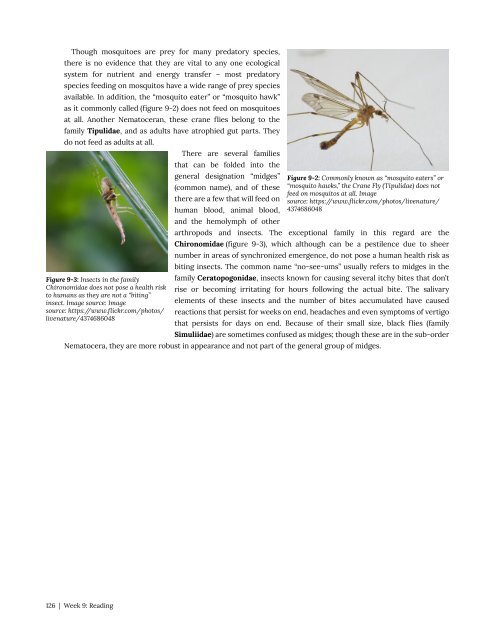Entomology 311 Lab Manual - 1st Edition, 2019
Entomology 311 Lab Manual - 1st Edition, 2019
Entomology 311 Lab Manual - 1st Edition, 2019
You also want an ePaper? Increase the reach of your titles
YUMPU automatically turns print PDFs into web optimized ePapers that Google loves.
Though mosquitoes are prey for many predatory species,<br />
there is no evidence that they are vital to any one ecological<br />
system for nutrient and energy transfer – most predatory<br />
species feeding on mosquitos have a wide range of prey species<br />
available. In addition, the “mosquito eater” or “mosquito hawk”<br />
as it commonly called (figure 9-2) does not feed on mosquitoes<br />
at all. Another Nematoceran, these crane flies belong to the<br />
family Tipulidae, and as adults have atrophied gut parts. They<br />
do not feed as adults at all.<br />
Figure 9-3: Insects in the family<br />
Chironomidae does not pose a health risk<br />
to humans as they are not a “biting”<br />
insect. Image source: Image<br />
source: https://www.flickr.com/photos/<br />
livenature/4374686048<br />
There are several families<br />
that can be folded into the<br />
general designation “midges”<br />
(common name), and of these<br />
there are a few that will feed on<br />
human blood, animal blood,<br />
and the hemolymph of other<br />
Figure 9-2: Commonly known as “mosquito eaters” or<br />
“mosquito hawks,” the Crane Fly (Tipulidae) does not<br />
feed on mosquitos at all. Image<br />
source: https://www.flickr.com/photos/livenature/<br />
4374686048<br />
arthropods and insects. The exceptional family in this regard are the<br />
Chironomidae (figure 9-3), which although can be a pestilence due to sheer<br />
number in areas of synchronized emergence, do not pose a human health risk as<br />
biting insects. The common name “no-see-ums” usually refers to midges in the<br />
family Ceratopogonidae, insects known for causing several itchy bites that don’t<br />
rise or becoming irritating for hours following the actual bite. The salivary<br />
elements of these insects and the number of bites accumulated have caused<br />
reactions that persist for weeks on end, headaches and even symptoms of vertigo<br />
that persists for days on end. Because of their small size, black flies (family<br />
Simuliidae) are sometimes confused as midges; though these are in the sub-order<br />
Nematocera, they are more robust in appearance and not part of the general group of midges.<br />
126 | Week 9: Reading


















